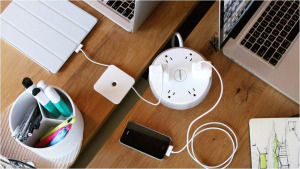by Judith Shuey
On June 24th, I was invited to do a quick live segment during the morning show on Fox 4 News. Since a majority of viewers during the morning hours would be watching from home, we thought it would be a good time to cover some tips about how to make working from home more efficient.
Over the last several years, many companies have seen a push for a reduction in real estate usage and related costs; paired with an increase in mobile technology, these factors have led to more and more people finding themselves being able to work outside the traditional office.
1. Find a clearly separate space.
The flexibility and freedom of working from home can blur the lines between the demands and responsibilities of both work and home, so it’s very important to find a space within your home that you can designate for work-related activities. This will allow you to focus on and organize your work-related tasks without the distractions of home life. Try to avoid camping out at the kitchen table or in the living room on a regular basis.

2. Make sure there is plenty of space.
You need to have space in order to do your work; depending on your job, you’ll want to make sure you can accommodate your technology, paperwork, reference materials and so forth. Don’t restrict your space to the point where you can’t change something about your space or layout as needed. If you handle a lot of paperwork, give yourself room to organize it all; think about whether you pile vs file physical documents and how the ability to see vs hide things will affect your ability to perform your job.

3. Furnish it right.
There are four furniture components to a successful home office: task seating, the desk, storage and lighting. Ergonomics should be considered with any of those components. Make sure the furniture allows you the flexibility to change postures throughout the day to eliminate fatigue and decrease work-related injuries. Lighting, whether natural or artificial, should be controlled in a way to reduce eye strain and encourage wellness.

4. Tame your technology.
Technology is a major reason for why you’re able to work from home. Consider different wire management solutions to keep cables and cords from taking over your space. Make sure you can power all necessary devices without overloading circuit capacity. Include data back-up management and power surge protectors to avoid any technology-related crashes.

5. Be a control freak.
When the lines blur between home and work life, consider establishing some ground rules to help create some balance. Clear starting and stopping times for work-related responsibilities are important, especially when you know that it can be hard to ‘turn off’ work when your technology is always on and connected. Control not only your furniture and lighting, but the security of your space as well. Sensitive materials should be put away or locked up after hours and data should be backed up as frequently as possible.

One more important thing to consider is the social aspect of work; there is a lot to share and learn when working in an office with peers and leaders. Just because your daily commute is cut back from across town to across your home doesn’t mean you should miss out on the benefits of learning from and interacting with your coworkers. Find ways to connect with people throughout the day and you’ll find that your experience with working from home will be better-rounded.

Design Director

